Fundraisers take note: it is estimated that four to seven billion dollars a year goes unmatched by nonprofit organizations. Eighteen million people around the globe have access to a matching gift program, and it’s been surveyed that one in every three people who donate would actually be willing to donate more if they knew their donation could be matched in the first place. Matching gift programs and volunteer grant programs are more inclusive of corporate employees because the causes that they feel personally motivated to donate to or volunteer with are recognized and rewarded by their employers. The digital marketplace for these opportunities is growing making it easier for nonprofits to find their match.
Tech tools for your arts job search
 After two years writing for Technology in the Arts, I am leaving the Center for Arts Management and Technology. The unfortunate part about being a graduate student is that you will have to leave a place you love after a certain number of years, and my number is up! Special thanks to David and the rest of the CAMT staff for making the last two years amazing, educational, and memorable.
I am very excited about my new position with the data-driven arts and entertainment consulting firm TRG Arts. I have been hired as the Strategic Communications Specialist, which means I will serve as a writer and editor for the firm’s consulting projects, Data Lab research and analytics projects, and a contributor to TRG’s knowledge center online.
After two years writing for Technology in the Arts, I am leaving the Center for Arts Management and Technology. The unfortunate part about being a graduate student is that you will have to leave a place you love after a certain number of years, and my number is up! Special thanks to David and the rest of the CAMT staff for making the last two years amazing, educational, and memorable.
I am very excited about my new position with the data-driven arts and entertainment consulting firm TRG Arts. I have been hired as the Strategic Communications Specialist, which means I will serve as a writer and editor for the firm’s consulting projects, Data Lab research and analytics projects, and a contributor to TRG’s knowledge center online.
Before I leave Technology in the Arts, I wanted to share some of the secrets I learned during the last few months of looking for arts jobs, mainly at non-profit organizations. Because nonprofits usually begin their fiscal year in July, new positions at these organizations are often posted in the summer. That means now is the prime time for you to find your new dream job in the arts.
Here are my favorite tech tools to help you find that job:
Changedetection.com
Arts jobs often need to be filled quickly, which also means the time you have to apply is limited. We’ve all had the experience of finding a great—no, perfect—job and finding out that the “apply by” date has passed or being informed after you’ve submitted your resume that the company had already extended an offer to someone.
Changedetection.com comes in handy when you know that there is a company (or companies) you’d love to work for. Obviously you aren’t going to check in on the employment page of their website every day. Better that you just be notified when they post a job, right? Well, through the magic of technology, you can find out when that employment page changes. Changedetection checks the page every day, week or month (you specify which) and sends you an email when there has been a change.
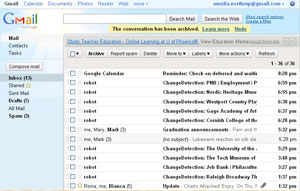
If there is a specific geographic location you know you’d like to work in, changedetection can help too. For example, I was looking for jobs in Portland at the beginning of my search. I looked on the arts council website and there wasn’t a job board, but I wasn’t going to let a silly little thing like that stop me! What the arts council site DID have was a listing of all the arts orgs in Portland. I put a changedetection on the employment page of each organization I was interested in and got on with my search.
The downside of tracking all these pages is that you might have to sort through some jobs that aren’t for you. For example, I looked mainly at full-time marketing jobs, but I was notified for ANY job at those companies, including development and box office jobs, and in some cases, internships. However, you can take this as an opportunity to build networks. If you see a great job in finance, maybe you have a friend who looking who also happens to be a finance whiz. Forward the job to her and not only have you strengthened your friendship, but also she may want to return the favor if she comes across a job that fits you.
I would recommend setting these up relatively early in your job search and keep adding as you find companies that are of interest to you. This way, you will also see which jobs come up and how frequently as well as important information like salary ranges and organizational structure information. (For example, will you be working for someone who is a new hire herself/himself? Is there a new Executive Director at the org?)
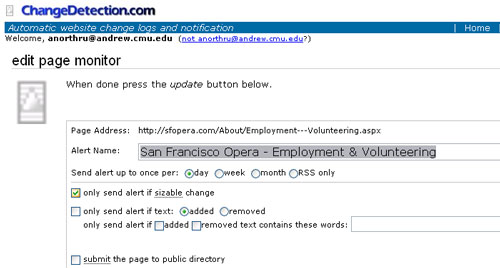
The interface for monitoring a page on ChangeDetection.com
LinkedIn has attempted to tout itself as a job-finding service. However, at the early-career/emerging leader level, I find that is less helpful for finding jobs and more helpful for simply networking. There’s not that many headhunters out there for arts jobs, except in the executive level and maybe for IT people.
Anyway, how many times have we heard that the arts world is a small world? I use LinkedIn to see if there’s anyone I know who may know someone at the company I am applying to. If your relationship is good with that person, ask them to put in a good word for you.
Sometimes LinkedIn groups will have job postings; I haven’t found this to be true for most of the arts admin/management groups though. Please comment below if you know of a good group for this.
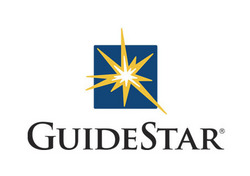 GuideStar
GuideStar
For non-profit organizations, it’s essential to check out the company on GuideStar. GuideStar is a free service that gathers and publicizes information about nonprofit organizations. Much of the information is geared toward donors and foundations, but there is a lot of useful information on it for the job seeker.
Once you register (free), you have access to almost any arts organization’s 990 tax forms, which means you can see what the organization’s budget size is and how they are doing financially. Note that for many organizations, the most recent year might be 2008 or 2009, so the information could be slightly dated or influenced by the recession—which is still important to know. The 990 serves not only as a way to see if the org has a record of keeping a balanced budget, but also as a historical snapshot of the organization, in terms of grants received, senior staff turnover, and capital campaigns and similar projects, among other things.
GuideStar is also extremely helpful to estimate salaries, especially if you are applying to a director-level position. The IRS requires non-profits to list the salaries of their five highest-paid employees. This is pretty valuable information, as the size of most non-profit arts organizations means that you aren’t likely to find very accurate information on that exact job at that exact organization.
Arts Jobs Sites
One of my friends posted a status update recently “wondering if CareerBuilder is really a builder”. I replied that all it had “built” for me was piles of emails in my spam folder. Personally, I’ve had a lot more luck overall with industry-specific sites, some of which can be used in conjunction with changedetection, as discussed above. (Bonus: The industry-specific sites manage to present you with jobs without asking if you want information from University of Phoenix every other time you go to look at a job. Just saying.) Here are my favorites:
General:
- CAMT’s own ArtsOpportunities
- Americans for the Arts' Job Bank
By discipline:
- Playbill Job Listings (mostly theatre)
- Theatre Communications Group's Arts Search (need a log-in and password for this one)
- Association of Performing Arts Presenters Job Bank
- Opera America Job Listings (also available as an RSS Feed)
- Dance USA Jobs in the Arts
- Association of Children’s Museums
- American Association of Museums' jobHQ
- Chronicle of Higher Education (mostly faculty positions at colleges and universities)
- Also, Createquity will occasionally post interesting opportunities, so that is worth adding to your RSS feed if you haven’t already.
State and local arts councils may have a good job posting site, depending on where you’re looking to find a job. For example:
- Greater Philadelphia Cultural Alliance
- Cultural Alliance of Greater Washington (Washington D.C., not Washington state)
- New York Foundation for the Arts
Lastly, if you have an interest in development or program management, heads up! There are a few sites/ email alerts that I’ve found especially useful:
Philanthropy News Digest (A service of Foundationcenter.org)
PND has created a job alert system that will email you a daily summary of recent jobs in your area of interest. I cast my net wide by checking a lot of states and position types (communications, development, program management, etc) when I signed up for the alerts. I now get about 15 job postings a day. The fields of the organizations are quite diverse too. A recent email contained jobs from Napa Valley Opera House, University of Chicago, the Rainforest Alliance, and Vera Institute of Justice.
Chronicle of Philanthropy posts mostly development jobs, which, like PND, you can sort by location, position type, and the field of the organization (education, health, museum, etc).
It’s also worth mentioning that DotOrgJobs is good for fundraising jobs and other nonprofit jobs; however, I have not seen a lot of arts-specific jobs from them. You can subscribe via email or RSS feed.
On organizing email alerts:
You might be saying to yourself, “That’s a lot of email alerts to deal with.” I use gmail and have set a rule to have these emails automatically labeled “job search” and archived so that they don’t clutter up my inbox. Then I set an alert on Google Calendar reminding me to go through them once a week, so that I actually read them! This can also easily be done with Outlook.
Do you know of any other good sources for arts jobs? If so, please post them below! Happy hunting!
10 Takeaways From the 2011 Emerging Practice Seminar
CultureLab, a partnership between an informal consortium of arts consultants and the Cultural Policy Center (CPC) at the University of Chicago, recently held an 'Emerging Practice Seminar' in April. The organization was formed to break down the silos of research, policy and practice, and create a new capacity and approach to tackling challenging issues. The topics at this year's seminar were:
- Uses of technology in audience engagement
- Revenue management and dynamic pricing
The seminar's website features all of the speakers' presentations (both videos and slides) and is an extremely helpful resource!
Here were my top 10 takeaways from the 'Use of Technology in Audience Engagement' portion of the seminar.
1. Embrace technological innovation, there's nothing to fear! Tim Roberts of ARTS Australia provided an introduction to the day's topics. Tim's introduction called attention to the unfortunate fact that any arts managers and organizations still view technology as something they are fighting against. He quoted NEA chairmen Rocco Landsman as saying "the arts are battling the technology invasion". Roberts argues that many also believed cable television to be the death of television and photography to be the death of painting and that technical innovation has not caused the death of an artform but has contributed to its spread and created new audiences.
Uses of Technology in Audience Engagement - Tim Roberts from Cultural Policy Center on Vimeo.
2. Engagement is an ongoing process: Technology is least effective when it's not used in a proper context of engagement. This process of engagement often begins prior to the audience coming through the doors. Likewise, the process shouldn't end after the performance or visit ends. Technology can help to provide context to a piece of art or performance, personalize the experience and even augment the experience. There are many options when it comes to sustaining a deeper level of audience engagement.
3. Layered Arts Experiences are cool! This type of technology has been extremely underutilized in the performing arts sector. Layered Arts Experiences offer audiences options for real-time assistance imperative during arts programs. They can come in the form of supertitles for opera and dance performances. The Columbus Symphony Orchestra had a device called the 'Concert Companion' which enabled patrons to read something about the piece they were hearing as they listened to the concert.
4. Museums continue to lead the way when it comes to adapting technology: Another common theme during the seminar was the overwhelming lack of technological innovation in performing arts organizations. Even though there were examples of organizations using layered arts experience tools and mobile interactions, it seemed as though they were few and far between and many had even stopped using these tools.
5. The verdict is still out on Tweet Seats: A 'Tweet Seat' is simply a seat reserved in a theater for Twitter users. Tweet Seats have many benefits, including: encouraging a younger audience demographic to get involved in the performance, having this demographic spread the word about the performance to their Twitter followers, and cutting down on distracting other audience members by blocking off a section for Twitter users. The question, however, remains whether or not people can truly become immersed in a performance if they are multi-tasking with other technological devices.
6. Mobile Interaction isn't just limited to QR Codes in Museums Ron Evans of Group of Minds had some great ideas about ways to engage audiences via mobile devices. Evans suggested placing a QR Code on tickets for previews of the show. Evans also suggested distributing digital keepsakes after shows. He also discussed the importance of using these mobile technologies in the proper context of audience engagement. Unfortunately, most technology has focused on the pre-performance and pre-sale with the sole intention of making the sale and increasing attendance. Engaging audiences should also involve increasing their understanding and appreciation of an artform. The 'during' and 'after' is just as important to leading people to the next experience.
Mobile Interaction: adding content and context - Ron Evans from Cultural Policy Center on Vimeo.
7. Location Based Servies has a long way to go: Devon Smith presented the findings of a research study she conducted on arts organizations using location based services. Location Based Service is simply a service that uses the geographical position of a mobile device (Foursquare, Yelp, Google Maps). Applications like Foursquare can be useful in providing real-time analytics on the demographic of those who are "checking in" to a venue. Smith's study found that only 36% of the 76 nonprofit theatres she tracked, had properly claimed their venues on Foursquare, yet 97% of the venues had a mayor. Even though claimed venues had 3% more activity, the real-time analytic information could be very useful to any organization.
8. Blogging Isn't Dead!: Thomas Wickell of Malmo Opera shared one of the most interesting case studies of the day. Wickell emphasized the importance of viewing the stage from the audience's perspective as opposed to looking out at the audience from the stage. With this key distinction in mind, Wickell and his team found that the audience they wanted to attract was not responsive to traditional channels of advertisement (newspapers, television, etc). Since most of their target audience were highly engaged online, the team created a blog that was centered around the life of a character in an upcoming opera. The blog became so popular, at one point in time, traffic to the blog surpassed that of the company's main website! The staff even invited readers to a ceremony for the character (since she does not survive) and over 100 people came to pay tribute to her life. The blog can still be found here!
9. Technological Innovation Often Requires a Culture Change Within an Organization : Linda Garrison and Thomas Weitz at Steppenwolf Theatre gave an overview of helpful practices for creating video content. An important theme during this presentation was the importance of finding allies when seeking to implement any changes. Whether designing a new video campaign or placing QR codes on marketing material, implementing new technology can often mean a culture change within an organization. Finding out who your champions, advocates and contributors are beforehand can make a world of difference when proposing any sort of change. It's also well worth your time to watch the Steppenwolf videos here.
10. Know Your Target! The Steppenwolf and Malmo case studies highlighted the importance of understanding who the target audience is prior to implementing any of the strategies and tools listed above. Steppenwolf researched and found their audience tended to be highly educated, comfortable with direct marketing and confined to a very specific geographic location. As a result, Steppenwolf decided that an online video campaign could be effective in engaging their audience. The Malmo Opera worked backward and began by envisioning what type of audience they wanted to attract. Either way, this process is extremely effective when the target audience is clearly defined.
The Art of Social Media Analytics, Part 3
Summer is the “off-season” for many of us in the arts world. Why not take this time to refresh your social media strategy? This is part 3 of our 3-part series on social media analytics tools. Check out Part 1 and Part 2.
 The last part of our series concerns making management decisions based on data. Once you have the data, what do you do with it? As we come up with more sophisticated methods to track social media sentiment and reach, it becomes possible to track more accurately how people are responding to social media. This is especially important because social media can be a valuable part of your market research. It is like a 24-hour focus group, answering many of the questions you may have about your audience as well as the questions you didn’t think to ask.
The last part of our series concerns making management decisions based on data. Once you have the data, what do you do with it? As we come up with more sophisticated methods to track social media sentiment and reach, it becomes possible to track more accurately how people are responding to social media. This is especially important because social media can be a valuable part of your market research. It is like a 24-hour focus group, answering many of the questions you may have about your audience as well as the questions you didn’t think to ask.
As mentioned in Part 2, there are a variety of questions that you may have about your audience and a variety of tools that track different measures of success. Some tools are narrowly focused on one measure, while others give you a conglomeration of these measures. Some examples of the measurements of success include:
- Sentiment: Are social media users referring to my organization positively, negatively, or neutrally?
- Conversions: How many and which fans are buying online (or offline)?
- Spikes in activity or “buzz”: How are social media users responding online to campaigns?
- Impact: How many people is the message reaching and how much influence does the organization have? How many people are sharing posts?
When thinking about measurement tools and management decisions, the first question is often, when is it worth it to pay for analytic tools? As technology evolves to be able to track more specific and more valuable information, more paid analytics tools have come on to the market. There are two basic instances where it’s worth it:
1) when you have a large customer base
2) when you need enterprise-level social media analytics
Firstly, if you have a large customer base or a large social media base (no hard and fast rule, but larger than 100,000) and you are literally having trouble monitoring comments on your brand, you need a tool that takes more of a summary view. Secondly, most paid tools are enterprise-level tools--tools that more than one person can manage or assign tasks to others and have other special features. If you feel you need this type of functionality, then paying for an analytics may be worth it.
Besides those two factors, a company should also consider the elusive “Holy Grail of Social Media,” return on investment, or ROI. Many organizations have found a “chicken and the egg” scenario of needing time and resources to show results (often, revenue), but needing results to convince upper management to spare the time and resources to devote to social media. This situation can be difficult; you might try proposing a pilot program or experiment with a cheap or free tool before proposing a larger investment.
One institution that has made a practice of using data to make decisions in social media (as well as investing in technology—check out their web and new media strategy) is the Smithsonian, under the guidance of tech guru Nancy Proctor. As one employee put it “why would you change anything without metrics and feedback?”
Once a company has the analytics tools in place it’s easy to observe your numbers of fans, interactions, and gauge the quality of those interactions. What’s more difficult is translating your observations into actionable decisions.
A simple example is that of David Horgan’s, eMarketing Specialist for Smithsonian Folkways Recordings. David had experimented with linking ads to their Facebook page and their homepage. “We found that the ads that direct people to our Facebook page (rather than to our homepage) were about 3x more effective on a cost per click basis.” Management Decision: Direct more ads to the Facebook page than the homepage.
Another example is the blogathon on the Smithsonian Collections Blog that Rachael Cristine Woody worked on for American Archives Month. According to Rachel:
Until that time we had almost solely focused on collections content. In October we shifted to also cover our profession and offer a more behind-the-scenes look at what we do/deal with, every day. These posts became the most popular posts we’ve published so far, numbering in the thousands for direct hits, and to this day still receive at least 100 hits a week. It was at that time that I think the blog truly found its most invested and engaged audience, and it helped to call attention to us that we should be covering more on our profession. Management Decision: In addition to giving the collections exposure, engage and influence the professional community by providing transparency, advice, and support.
The National Museum of American History combined traditional survey techniques with data from analytics tools (Google Analytics and WebTrends data, click metrics from HootSuite, etc.), comparing the results of four closely-related surveys on each of four major communication channels (their blog, email newsletter, Facebook page, and Twitter feed). Although more complex, the results allowed Dana Allen-Greil to make decisions regarding how the Smithsonian communicated with patrons:
At the National Museum of American History, we’ve long had a hunch that our Twitter feed should focus on conversational and educational content, rather than marketing in-person events. If our followers aren’t local, do they really want to hear about events they can’t come too? Click metrics from HootSuite plus data from a survey of our Twitter followers gave us solid footing to make the case against Twitter as a platform for driving foot traffic to the museum. Less than 25% of responders reported planning a visit to the museum after seeing a message from us—this is compared with over 55% of email subscribers who said they did. Even more to the point, less than 10% of Twitter followers reported attending an event compared with over 30% of our email readers. We discovered a similar trend with our Facebook fans and have altered our content strategy accordingly. Management Decision: Use Email (not Twitter) to Promote Synchronous, Location-Specific Events.
More info on Dana's Twitter content strategy can be found here.
So there you have it. As much as social media can seem nebulous, there are specific things to measure, to think about and analyze, and then to make decisions that you can feel confident about. When you develop your social media strategy for your next season, mix things up a bit with some new questions about your audience, new tools, and a new perspective on the art of social media analytics.
Special Thanks to the following people for their contributions to this series: Michael Edson, Brian Hinrichs, Maggie Johnson, Katryn Geane, Kristin Garbarino, Devon Smith, Lindsay O’Leary, and Crystal Wallis.
The Dynamic Box Office
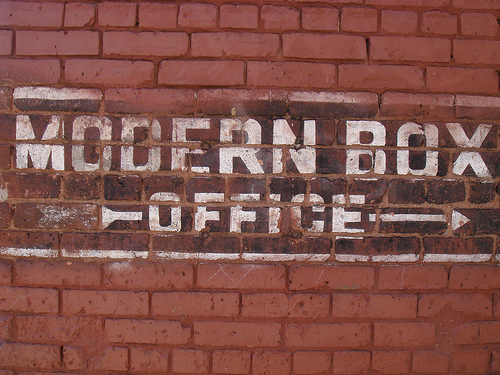 Airlines have been doing it for years. Ticketmaster (in its latest incarnation) recently jumped on the bandwagon.
Airlines have been doing it for years. Ticketmaster (in its latest incarnation) recently jumped on the bandwagon.
Dynamic or variable ticket pricing is the strategy of altering ticket prices based on different variables. (As noted in the comments below, "Variable pricing is setting BASE prices according to differences in performances' time of day, day of week, etc as in paragraph 2 (a midweek evening may be less expensive than a Sunday matinee, for instance). Dynamic pricing, on the other hand, changes prices after the initial on-sale in response to changes in demand over the sales cycle." I use the term "dynamic pricing" in this article to discuss changes made to prices once the tickets have already gone on sale, altering FROM the base price. Thank you for pointing this out, Kara!) These can include everything from the number of seats already sold at the time of purchase, the proximity of the show date, alternative entertainment options on the show date, anticipated weather, and any number of factors that the host deems as having an impact on ticket prices. It is perhaps a more realistic and “fair” way to price tickets, allowing the cost of tickets to reflect the actual supply and demand of the market. This should result in minimized dead-weight loss, which benefits but the consumer and the supplier. For performing arts organizations, grappling with decreasing advance-ticket sales and discounting options that gouge profit margins, dynamic pricing might be “just the ticket.”
Unlike regular discounting or promotional pricing, the dynamic ticket model would enable organizations to price each production—and even each performance--strategically and, perhaps, more realistically. Instead of offering incentive discounts, both the organization and the audience would be able to gauge expectations for a show based on the ticket prices. Declining ticket sales and decreased subscription renewals lead marketers to worry and wonder about the most effective way to promote ticket sales. A common “solution” is discounting, which leads to a host of other problems. Ron wrote this piece for Group of Minds outlining what the major drawbacks to discounting. Rather than reiterate what he has already presented so well, I will simply say that I agree with his concerns about this eagerness to discount in order to get butts in seats. Considering these issues may make dynamic pricing a more attractive option for some.
A great example of the potential for dynamic ticketing is its recent use outside of the airline industry-- the newest Ticketmaster/LiveNation partnership is exploring the efficacy of dynamic pricing for sporting events. Last year, an article in Sports Business Journal did a great job outlining the way that dynamic pricing works at the San Francisco Giants’ AT&T Park.
There are a couple of key sentences in this article that I wish to address as they pertain to the performing arts industry:
- “Advanced software analyzes market conditions and determines a pricing recommendation that team executives can either accept, deny outright or tweak.” That’s the kicker: advanced software. I know that the biggest question is always: how can my organization do this? Non-profit performing arts organizations already face challenges being short on staff; the responsibility and complication of daily ticket price changes could be a full-time job in and of itself.
Analyzing the results of the 2011 Ticketing Software Satisfaction Survey, most respondents indicate that box office systems are either custom-built, cobbled together, or some of the solid, inexpensive options available to organizations. I went through and sent inquiries to the organizations listed in Amelia’s overview of the ticketing software survey results, as well as some others that respondents are using.
Unfortunately, at this time, nobody seems to have an easy-to-use “dynamic!” function in their software that makes it easy for an organization to alter prices without sending an actual staff member in to change them by hand each day. But the conversation is building in volume, and a few companies expressed that they can either design such a component for their clients, are looking into offering dynamic pricing in the future, or would like to know more about the demand for this function before they pursue including it in their products. (Just before posting this, I received the following from ProVenue: “We have no dynamic pricing customers in the UK as yet, however we do in the US. Please click on (this link) for details. We are looking to release in the UK sometime in the new year.” (I learned that ProVenue is part of the company that provides this model to the Giants. How accessible this component is for budgets that may be more modest than those of the Giants, however, is a question that I have yet to get a response to.)
- “(S)hould a game get rained out, standard refund and exchange policies would apply. But if a fan pays a premium price to see a particular player, such as a starting pitcher, and that player doesn’t play, there is no refund.” This quotation makes me smile, because in the performing arts, understudies are just part of the game. It does beg the question, however: what if someone paid a price bump because of a certain headliner, and that artist’s understudy performs that night? Does the ticketholder get a refund of the difference? We are all familiar with understudies and what that can mean.
- Perhaps the most universally applicable part of this article is the section “What’s the payoff?” As it outlines, “Dynamic pricing structures can provide significant cost savings for fans over original list prices for lower-demand games, and for teams, provide another means to help fill seats, generate additional concession revenue and potentially upsell that fan into a larger, future purchase. And for higher-demand games, dynamic pricing provides teams a revenue maximization tool to capitalize better on that heightened fan interest.” So actually, dynamic pricing could give us in the performing arts a real understanding of how our work is valued. We make a lot of guesses, some educated, some not, to try and figure out what the “best” price is for the work that we produce. Could dynamic pricing remove some of the mystery, and help us maximize both the number of tickets sold and the revenue generated?
Some may balk at the idea, as Diane Ragsdale does in this article on dynamic pricing in the non-profit sector. She quips, “Let’s call a spade a spade. Dynamic pricing is a method for maximizing profits….Suddenly increasing ticket prices in response to high demand, and selling ‘premium’ seats priced as high as people are willing to pay, strike me as questionable practices in a nonprofit organization.” What will it take for people to stop associating “non-profit” with “NO profit”? She likens dynamic pricing in the non-profit performing arts sector to soup kitchens charging for certain perks. What an unfortunate and offensive comparison. Non-profit arts organizations are businesses, regardless of their tax status or their primary sources of funding, and selling tickets is a fundamental component of what they do. Certainly, there are organizations whose missions might preclude them from dynamically pricing their tickets (e.g. “free art for all”), but there are others for which dynamic pricing could help generate more revenue (not a bad thing) and bring in more audience. As Lori Kleinerman of the Goodman Theatre remarks in her compelling talk on the Goodman’s use of variable and dynamic pricing, “We are aware of our civic responsibilities as a not-for-profit institution, so it’s important that we are accessible while still optimizing our income.”
There are many ways to apply dynamic pricing within the performing arts sector, and with more use some things may become evident. It is possible that it is a practice best suited for venues that do not scale their houses, or best applied to the “nose-bleed” sections, or only effective for the blockbuster shows. Of course, the key word there is “possible.” As we lament the decline of ticket sales, the loss of revenue when we discount with programs like Groupon and LivingSocial, and the oh-so-onerous epidemic of last-minute-ticket-buyers, why not consider dynamic pricing as an alternative model for revenue generation? After all, we may be “non-profits,” but that doesn’t mean that we aren’t subject to the supply and demand curves that drive for-profit business economics.
The Art of Social Media Analytics, Part 2
Summer is the “off-season” for many of us in the arts world. Why not take this time to refresh your social media strategy?
This is part 2 of Tech in the Art’s 3-part series on social media analytics tools. Check out Part 1.
This part of our series is based on a simple question: As of today, what are your options for social media tracking? Let's take a look at some popular analytics tools and how to evaluate them given your organization’s more specific goals.
The Next Level
So let’s say you help determine social media strategy for your organization. If you’re like many organizations, you have Google Analytics, you look at your Weekly Facebook Update, you respond to comments on Facebook and/or Twitter. Your workload is, for the most part, tenable, and your social media presence is flourishing.
First of all, great job!
How can you take it to the next level without spending an inordinate amount of time or money? Get serious about analyzing your efforts and seeing what’s working. Using an analytics tool, you can begin tracking your efforts formally over time, just as you probably have a formalized system of tracking ticket revenue through sales reports. Some analytics tools offer a sort of moment-in-time snapshot. Others track over time as well.
So, as you endeavor to improve your tracking, which tools are for you? Here are a few questions to ask yourself:
1. Exactly how much time per week or month am I able/willing to devote to researching our followers/fans and the analysis of our data?
2. What am I interested in knowing about my social media presence? Examples include:
a) Who are my fans? (donors, members, subscribers, employees, artists, etc)
b) How much of an impact am I having? (Am I reaching key influencers? How far are my posts being shared?)
c) How much of a return I am seeing on my investment of time or money?
4. How much money (if any) am I or my department willing to spend and what do we expect for that money? (See Question 2)
5. On a related note, how much buy-in will you get from senior management/the board? Will data provided by these analytics aid your case in advocating for future social media campaigns?
6. Who will be maintaining a regular schedule of analyzing the data? Yourself? An intern? Someone else?
There are hundreds of tools out on the market, and more emerging everyday. Since there is no way for this list to be comprehensive, here is a list of our favorites at Technology in the Arts. If you know of other useful tools for tracking social media, please comment on this post.
Disclaimer: For the sake of limiting the project in some way, we have included only 3rd party social media sites—that is, mainstream social media sites that are set up for external relations with the general public, like Facebook, YouTube, Twitter and the like. We will not cover basic brand management tools or web analytics tools like Google Alerts, except that in terms of tracking conversions from social media.
Free tools
bit.ly used in conjunction with Google URL Builder/Google Analytics
If you’re already using Google Analytics for your web analytics, one of the smartest things that you can do is track click-thrus from social media to your website. Here at Technology in the Arts, we do this through Google URL Builder and bit.ly. Earlier this year, Tara gave us an in-depth look at Google URL Builder. Basically Google URL Builder equips you with the ability to tag any URL you link to in your social media posts. You specify the campaign, medium (Twitter, Facebook, feed, etc) and a few other details about the link and, voila!, you can track click-thrus from your social media platforms.
Using Bit.ly gives you the added bonus of shortening the links and creating QR codes as well as tracking of any link, even those you’re not tracking through Google, with registration (free).
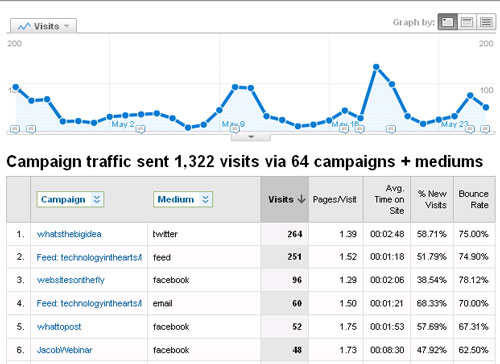
Think up
This program stores all your posts, tweets, replies, retweets, friends, followers and links on social networks like Twitter and Facebook in a database that you can easily search, allowing you to analyze and export the data.
What’s unique about this is that it puts the data directly in your hands rather than giving you the results of the analysis. This means you can slice and dice any way you like, beyond any restrictions the program might impose upon you.
Flowtown
“If social and email had a baby, it would be called Flowtown.”
- Dylan Boyd, Vice President, eROI
When I first started researching social media analytics, I held a focus group with social media experts, one of which was Devon Smith of the 24 Usable Hours blog. She suggested Flowtown, which she reviewed in detail last fall.
The concept is that it helps you manage your email list in the context of social media. Flowtown is currently renovating the tool; however, you can sign up to be notified when they are accepting new users.
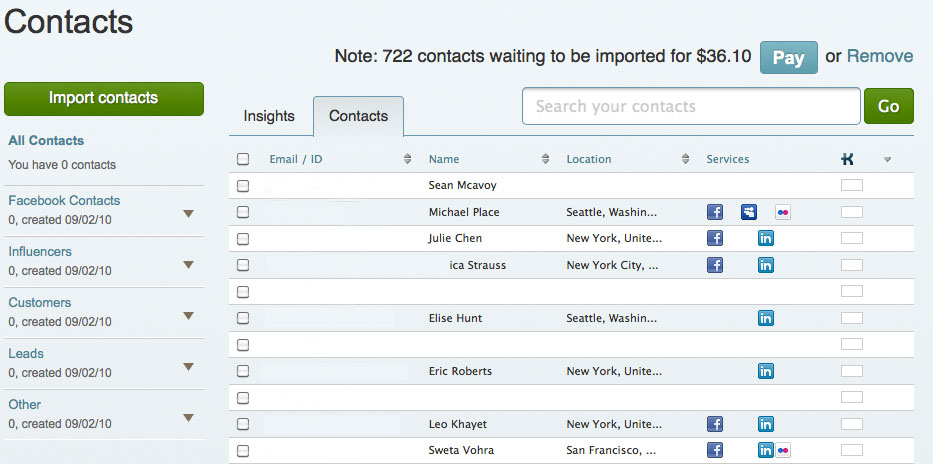
Social Mention
Social Mention analyzes interaction from across the social media universe--Not only Facebook and Twitter, but other social media sites like Digg, StumbleUpon, YouTube. It gives you a snapshot of how your social media presences are faring. One of my favorite features is the focus on sentiment. A common feature for paid tools, you get information on how your brand is perceived—in a positive, negative or neutral way—for free.
Klout.com
Klout is one of the most comprehensive systems for social media analysis. The tools help you track your presence over time, measuring things like influencers, reach, the probability for the message to be amplified (shared), and more, all of which contribute to an all-around Klout score. Another useful feature is the ability to compare yourself with other organizations.
TweetEffect.com
Tweeteffect is helpful in finding out which tweets are most “effective”, specifically by finding out which tweets cause you to lose and gain followers.
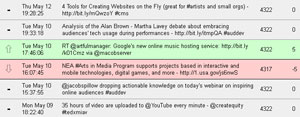
TweetPsych.com
Tweetpsych is a tool which tells you simply who you are to the people who follow you. The platform describes itself as creating a psychological profile of the twitter account, which is done by comparing how often you tweet about a particular topic in comparison to the “average” Twitter user. For example, techinthearts tweets about work, media, and learning more than the average Twitter user, and about the past, anxiety, and self-referencing tweet less than the average user.
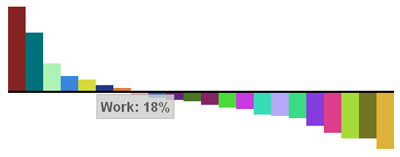 Facebook Analytics
Facebook Analytics
The only consistently good free option for tracking Facebook is the Facebook analytics tools. The tools are a lot better than they used to be, especially with the recent upgrades that let you see how many impressions each of the items you post on the wall receive from your fans. However, Facebook tools don’t have the same capabilities as the Twitter tools to give an accurate picture of who is being reached.
Paid tools
Radian6 ($500/mo)
Radian6's philosophy is pretty simple: Listen, Measure, and Engage. And by "listen," doesn’t just track Facebook and Twitter—they monitor across blogs, forums, news, and more. You can track topics by keywords, basically listening to the conversation about why your customers come to you in the first place rather than just monitoring your own brand name. So, monitoring internet chat about string quartets and classical music if you are a Chamber Music Society.
Radian6 offers tons of ways to measure all the data you've "listened" to. It allows you to slice and dice data of social media on par with Google analytics and more, such as identifying key influencers and tracking the lifecycle of buzz around your campaign or brand. Another thing they measure is Share of Conversation: how often is your brand (say, MoMA) mentioned in the conversation about the general topic (arts in New York)?
Finally, this tool facilitates engagement with customers with integrated workflow, alerts, and sentiment monitoring. You can assign different people to be the Community Managers for different topics or audiences who respond to those constituents personally. Radian 6 also advocates contributing to the conversation by contributing white papers or other research to the topic.
Coremetrics (price varies)
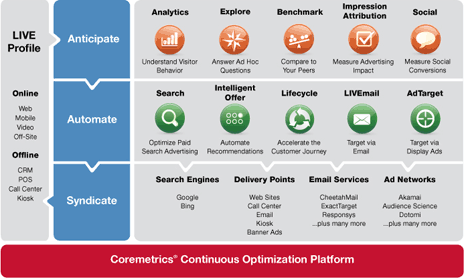
If Radian6 looks at the big picture, Coremetrics (IBM's answer to analytics software) drills down to the individual customer level. Its main strength is that it is a comprehensive marketing system, integrating different channels and even offline information to convert and retain customers online. They also have a three-step philosophy: anticipate what your customers want based on cross-channel historical data, automate an immediate response to customer actions, and syndicate personalized content to the customer via the right channel at the right time.
Coremetrics puts all of your data--social media, CRM database, etc--into one application and measures it with the same metrics. This allows you to segment your customer base according to any and as many characteristics as you want to create the ultimate personalized experience.
BONUS: Coremetrics publishes informative white papers on analytics that you can download in exchange for an email address.
ComScore (price varies)
ComScore is another "360-degree" tool. Like Coremetrics it unites web analytics and social media data. The difference is that ComScore uses a consumer panel of approximately 2 million consumers worldwide to measure people's behavior in the digital environment. ComScore's Social Analytix tool is powered by Radian6, but when combined with ComScore's other tools, you can integrate social media measurement with other analytics tools. ComScore’s analytics toolbox is vast and covers a multitude of different needs, including ad effectiveness, search marketing, mobile, and cross-media measurement.
Twitalyzer ($30/mo)
One of my favorite free tools is now a paid tool, but it is still affordable to many non-profits. At only $30 a month, Twitalyzer not only tells you what is happening with your Twitter account in terms of reach, impact, and the other metrics we’re familiar seeing in association with social media, but it give you concrete recommendations on how to improve your outcomes based on more successful Twitter users. For example, I did a social media analysis for a client last year and Twitalyzer told me that:
If @"ClientName" is interested in having a more measurable impact in Twitter we recommend the following:
● It is moderately important that you find more followers ● It is moderately important that you find a few more people to follow yourself ● It is moderately important that you engage others in conversation more frequently ● It is very important that you write more frequently
Few tools on the market actually connect the dots by analyzing data and then telling you what you should be doing. If you can afford it, it's a good tool for those starting out as well as those re-orienting their social media strategy.
Next time in Part 3: Basing management decisions on the data you find with these tools (in case you aren't using Twitalyzer), including when it is worth it to pay for an analytics tool and examples from the Smithsonian on the concrete actions their staff has taken based on social media data.
The Art of Social Media Analytics, Part 1
Summer is the “off-season” for many of us in the arts world. Why not take this time to refresh your social media strategy? This is part 1 of our three-part series on social media analytics tools.
Social media marketing is an artistic endeavor as well as a scientific one. We use the right side of our brains to create the perfect message that will engage our audience and the left brain to crunch numbers on views, comments, etc. We know instinctively how to talk to our audiences, but we don’t always know how they are reacting to that message beyond a peripheral “feel” of the importance and sentiment behind the comment or action. There is often not an obvious way to categorize or quantify reactions to gain insights into your audience’s thoughts and feelings and to chart your own impact.
With the economic situation as it is right now, nonprofit employees are under more pressure than ever maximize their productivity and capacity. With technology, and social media in particular, as the most nebulous, mysterious, and constantly shifting elements of an organizations’ marketing/PR operation, it can be frustrating to track social media interactions and to gain resources from management for social media. Often initiatives face “death by delay” or end up being based on assumptions rather than data. At the Center for Arts Management and Technology, it’s one of the issues we talk about most often amongst ourselves and to clients.
It’s not just the arts, though.
In the non-profit arts world, we have the tendency to think that we are insulated and that our problems are due to a lack of time or resources. Some of these questions are ones that the social media field as a whole is trying to answer. While in the Masters of Arts Management program, I participated in a Social Media Analytics class where we had real-life clients. My team was working on the account of a major sportswear manufacturer. At first I thought that the questions that this company would have about social media would be very different than the ones that I worked on at the Center for Arts Management and Technology for our mostly non-profit arts clients. However, the more we worked with our client, the more similarities I noticed in the questions they asked about ROI, tracking, and analysis of social media initiatives.
Throughout the research that I’ve done and the conversations that I’ve had, I’ve heard social media right now described it as “the wild west”. Like web analytics was in its infancy, we are just now building the hallmarks and benchmarks for social media analytics. It’s an exciting time, and an extremely fast-paced one. If you have been keeping up with how businesses are using social media for the last five years or so, you’ve seen Facebook dominate MySpace, then Twitter edge its way in. As we moved to mobile, a slew of geo-location platforms arrived on the scene and now we’re trending toward game-based platforms.
As much as social media trends change, it is imperative to have a social media strategy, not just to spend your marketing dollars most effectively, but also to get to know your audience better. How do you get a social media strategy? You need information first. That’s where analytics come in. There is a wealth of information about your patrons hidden in their interactions on social media—like your own on-going focus group. But (A) how do you get to that information and (B) how do you draw conclusions from it?
A. As of today, what are your options for social media tracking? There are thousands of analytics tools out there and more being developed every day. Nonprofit arts organizations are faced with a dual bottom line: to serve the community and to create, present or preserve great art. Which tools are most useful to a nonprofit arts organization in gauging how they meeting the dual bottom line? In Part 2 of this series, we’ll take a look at some popular analytics tools and how to evaluate the tools out there given your organization’s more specific goals.
B. How can you use analytics data to make management decisions? There are many ways to slice and dice the data you might get from those tools. What are some strategies for using the current tools available? How can you make a confident decision about what is essentially a moving target? Given the tools and tactics in the above questions, when is it worth it to pay for analytic tools? In Part 3, we’ll address the problem of structuring your social media tracking efforts to find information relevant to your day-to-day decisions.
4 Tools for Creating Websites on the Fly
 Recently, I’ve been hearing about website creation platforms for artists, musicians, and designers. (They are also great for student portfolios!) These days, many people are starting to focus their efforts on mobile apps or websites, but still more may lack a functional, easy-to-use website in the first place or need a secondary site, like a company intranet or a micro-site for an exhibit or show.
I’ve found four that are worth checking out if you’ve been thinking about creating a website. The interfaces for these website creation platforms are very easy to use, with no coding required. If you have all your copy ready and your songs or artwork prepped, you can create a professional-looking website in about an hour, hosted by the site. Many of them are cheap or even free. Here’s a four tools for creating a website on the fly:
Wix.com: Individual artists and small organizations
Recently, I’ve been hearing about website creation platforms for artists, musicians, and designers. (They are also great for student portfolios!) These days, many people are starting to focus their efforts on mobile apps or websites, but still more may lack a functional, easy-to-use website in the first place or need a secondary site, like a company intranet or a micro-site for an exhibit or show.
I’ve found four that are worth checking out if you’ve been thinking about creating a website. The interfaces for these website creation platforms are very easy to use, with no coding required. If you have all your copy ready and your songs or artwork prepped, you can create a professional-looking website in about an hour, hosted by the site. Many of them are cheap or even free. Here’s a four tools for creating a website on the fly:
Wix.com: Individual artists and small organizations
One of the easiest, cheapest (free!) options I’ve seen out there is Wix.com. It produces great looking websites, with hundreds of free templates. Best for individuals or small groups, there are lots of options for photographers, designers, or artists here, and I also saw a few modeling/acting pages and a musician page with a music player for musicians or ensembles.
Wix is really good for people who just need something simple and don’t care too much about the site being particularly flexible. For example, I ran into problems posting lengthy text (like a full resume) in the page of the website, because the page sizes are set. Of course, you always have the option to link to an outside page or a PDF if this happens, but it’s important to be aware of the limitations. For this reason, I would recommend this tool to individual artists/ensembles or smaller organizations who just need something simple that they don’t necessarily want to deal with updating very often.
Another disadvantage is that Wix uses Flash, which means that the site cannot be viewed on iPhone, but for sites that will likely be viewed only on desktop/laptop computers or Android phones, Wix is fast, easy, and free.
Google Sites: A helpful collaboration tool
Google Sites (formerly Google Pages) also has some good options for individual artists, but what really impressed me was the templates built specifically for business collaboration. These sites may be useful for arts managers who are working on projects with outside companies or production managers who are trying to coordinate a design team who are working in 5 different cities in the initial planning phases of a production. Google also emphasizes that many businesses use Google Sites for company intranets or wikis.
There are a number of versatile templates, which you can play around with here.
Maestro WebBuilder: Classical Music Organizations, Ensembles and Artists
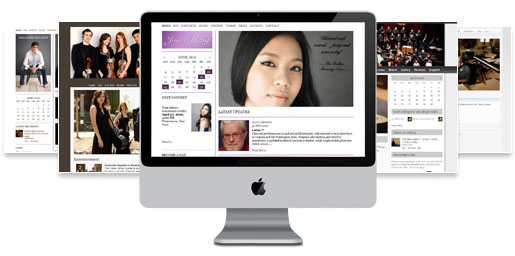 For those of you who are still hung up on the Flash-iPhone compatibility issue, I have two tools for you: InstantEncore’s Maestro WebBuilder and WordPress. Maestro WebBuilder is part of the InstantEncore suite of tools for classical music organizations and musical artists who primarily play classical music. (We had a fascinating interview with the COO of InstantEncore a few months ago--check it out.)
For those of you who are still hung up on the Flash-iPhone compatibility issue, I have two tools for you: InstantEncore’s Maestro WebBuilder and WordPress. Maestro WebBuilder is part of the InstantEncore suite of tools for classical music organizations and musical artists who primarily play classical music. (We had a fascinating interview with the COO of InstantEncore a few months ago--check it out.)
What’s great about Maestro WebBuilder is that, by building your website through InstantEncore, you are already set up to pull all the information into a mobile website or app. Maestro WebBuilder is a paid tool, but it's cheap, and it gives you the flexibility to easily convert content on your site into a mobile platform and makes it extremely easy to streamline all your social media presences into one system.
Wordpress: A tool for nearly everyone and everything
When you think of WordPress, you probably automatically think “blog”, but you can also build a nice-looking and functional website on the platform. Of course, it is the ideal choice if you want to fold a blog into your site. For example, the Technology in the Arts blog is run on WordPress. The front page is the most recent blog articles, of course, but we also have a number of “static” pages or pages that change less frequently with (shameless plug) resources for the arts field, publications we’ve produced, and webinars focused on ways that arts managers can use technology to meet their mission and goals.
With WordPress, there are thousands of templates out there, some of which are cheap and some of which are free. You can find a very professional-looking one without spending a lot of money. Ceci Dadisman of the Operagasm blog is a big advocate of WordPress as a way for arts organizations to save money.
It's also a good option if you are not a web expert, but want to/are willing to learn the basics of content management and HTML. It's easy to set up and maintain a basic site, but there's room to grow if you decide to get fancy. There are the thousands of WordPress plug-ins out there that you can download to jazz it up. For example, look at the top of this post. See the box with the number of times this article has been tweeted? That’s a WordPress plug-in! Scroll down to the comments section. Disqus pulls in comments from Twitter and Facebook. That’s also a WordPress plug-in! You have lots of options to connect your site with the greater community.
Philanthroper: A New Daily Deal Site for Non-Profit Donations
 A new daily deal site launched this past month, but this site doesn’t offer a deal for a spa trip or half off dinner at some posh restaurant. New site Philanthroper offers a non-profit story a day, a daily solicitation for a non-profit doing some good, and asks visitors to give just one dollar. Launched by Mark Wilson, reporter for Gizmodo and Esquire, Philanthroper aims to make donating a daily habit for the internet culture.
The idea behind Philanthroper is very similar to dynamite daily deal sites like Groupon and Living Social. Each non-profit gets front-page realty on the site, but just for 24 hours. Instead of a daily discount, Philanthroper shares the stories of non-profits, from local to global, and gives visitors the opportunity to donate a dollar. When the 24 hours come to an end, a new non-profit goes up and the previous day’s organization receives their funds within about a week.
A new daily deal site launched this past month, but this site doesn’t offer a deal for a spa trip or half off dinner at some posh restaurant. New site Philanthroper offers a non-profit story a day, a daily solicitation for a non-profit doing some good, and asks visitors to give just one dollar. Launched by Mark Wilson, reporter for Gizmodo and Esquire, Philanthroper aims to make donating a daily habit for the internet culture.
The idea behind Philanthroper is very similar to dynamite daily deal sites like Groupon and Living Social. Each non-profit gets front-page realty on the site, but just for 24 hours. Instead of a daily discount, Philanthroper shares the stories of non-profits, from local to global, and gives visitors the opportunity to donate a dollar. When the 24 hours come to an end, a new non-profit goes up and the previous day’s organization receives their funds within about a week.
Why just a dollar? As the site states:
So you can donate another $1 tomorrow. And another the next day. Use Philanthroper daily, and we guarantee, you'll donate more over time than you would have otherwise plus it won't sting your bank account so badly. Use Philanthroper every day and you'll be on the right track to give more, more easily. If you're compelled to make a larger donation, fantastic. We always link their site. So go for it.
Philanthroper restricts the amount you can donate to just that one dollar and limits visitors from donating more than once a day. The idea here isn’t to solicit a major gift, but to create a culture of daily giving. Donating a single dollar can be a pretty tempting request. Personally, I spend more on a cup of coffee or downloading an app that will make my phone sound like an air raid siren.
The financial cut Philanthroper takes from each donation is the biggest thing setting them apart from other crowdfunding sites like Kickstarter and USA Projects. That’s because the amount Philanthroper retains is zero – you read that right, zero. Philanthroper states right out that they will never take a cut of your donation, although the site’s payment service mPayy will take a whopping 1% of each donation – a penny.
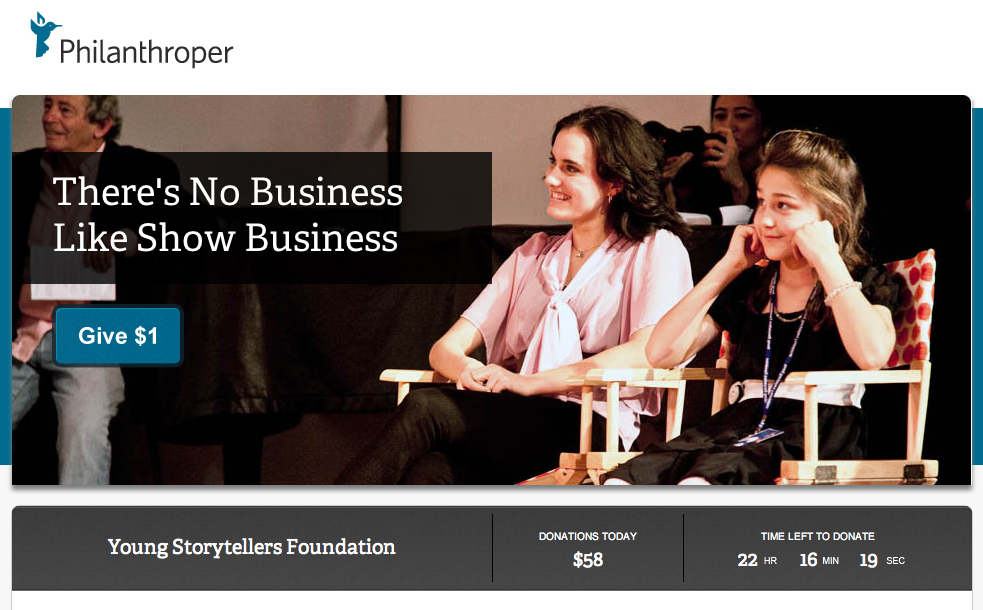
This is how Philanthroper can offer that minimum donation level of $1, whereas other non-profits are often forced to ask for a minimum of around $10 due to the processing rates of current payment services. Support for the site comes from advertising, so as website Arstechnica puts it “…only your eyeballs, and not your charitable gifts, are paying to keep things going.”
How does a non-profit get a daily deal? The site selects only official 501(c)3 organizations, with a special interest in those that bring in less than $1 million per year. The main focus is on those non-profits that are young and growing and could use every single extra dollar. Religious non-profits are not promoted on the site and individuals raising funds will not make the cut. Think you know a non-profit that’s perfect for the site? Philanthroper invites site visitors to suggest tips for non-profits out there worthy of their own daily deal.
Creating a habit of daily giving in our current internet culture is a pretty exciting idea. Philanthroper is taking advantage of the impulsive nature of users of sites like Groupon and Living Social. If the popularity of the site can continue to grow, there is a possibility to make a huge difference for many small non-profits. Visit the main site here and check out what today’s daily cause is that you can throw a dollar towards.
Google Apps: Cost Effective Tools For Your Organization
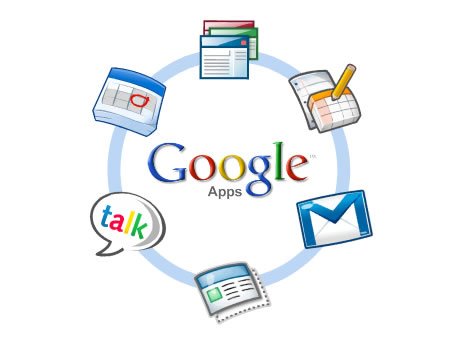 For smaller arts organizations and individual artists, buying various types of management software packages and setting up services for data back-up and storage can really eat into what may already be a tight budget. But having these software and services are essential to efficient, day-to-day management. This is where Google Apps could be a great, free to low-cost solution.
For smaller arts organizations and individual artists, buying various types of management software packages and setting up services for data back-up and storage can really eat into what may already be a tight budget. But having these software and services are essential to efficient, day-to-day management. This is where Google Apps could be a great, free to low-cost solution.
Google Apps is a suite of online software and storage tailored to the needs of organizations of different sizes. All of the apps (you can see a list of the core apps here) operate within your internet browser. This means that there is no software to be installed on your organization’s machines. This also means that updates and IT maintenance for the software will be handled for free by Google, though the service varies depending on which package you select.
If there is a more specialized need such as CRM or photo editing, Google Apps for Business comes with its own app marketplace. Similar to the app stores for iPhone and Android, the marketplace has a variety of free, more specialized applications to add to your Google account. All of the apps are desktop applications, but many of them work for both desktop and mobile devices.
So using apps that run in an internet browser are nice, but where is the information saved? While you can save your information to a personal computer or device, data storage and back-up can also take place in cloud storage. One of the main advantages to cloud storage is that your data can be accessed from any computer with an internet connection. It is important to note that storage only comes with a Google Apps for Business account.
I will admit that some of these Google apps do not have the same depth and power as other software packages, like the Microsoft Office Suite, but they definitely get the job done and fill the majority of the needs for most day-to-day operations. If the specific utility you need isn’t available in one of the core apps, you can usually find what you need in the marketplace.
There are three different types of accounts :
- Google Apps (up to 50 accounts) - This option is free and allows your organization to add up to 50 user accounts. Comes with the basic core of google apps, but lacks some of the more specialized business features and support as the other options.
- Google Apps for Business - The business version comes with all of the amenities including apps, storage and support. The pricing of this version is based on how many users you have in your organization, each user added costs $50 per year.
- Google Apps for Nonprofits - While this option does not come with storage, it is more robust than the free version, plus customer support is offered. Google grants discounts (40%) to larger non-profits, of 3,000 or more, for the business version and offers smaller non-profits the education version for free.
So for many organizations that operate on smaller staffs and for individual artists, this is an extremely cost-effective way to get some quality management software and storage.
Fair Use of Dance-Related Materials: A Discussion
In response to CAMT's "Social Media, Video Footage and the Law" white paper, Lisa Niedermeyer from Jacob's Pillow Dance Festival contacted us with a related video about fair use as it relates to dance-related materials. As the white paper mentions, fair use can be a nebulous concept as far as what, how, and how much copyrighted material can be legally used. The video is a more detailed discussion of The Dance Heritage Coalition's published statement "Best Practices in Fair Use of Dance-Related Materials". It features curators, archivists, documentary filmmakers, librarians and other collectors of dance-related materials discussing what they currently regard as reasonable application of the Copyright Act's fair use doctrine.
Future Focus: The Public Art Archive
 Sharing information and digital media about public art has never been an easy task for arts administrators. The Western States Arts Federation (WESTAF) seeks to change that when they launch the Public Art Archive - an online, searchable database for public art in the United States. A tool for both arts administrators and the general public, WESTAF’s vision is for the Archive to serve as an easy to use, central source of information about public art. I recently had a chance to speak with the creators of the Public Art Archive and take a guided tour through the site.
Sharing information and digital media about public art has never been an easy task for arts administrators. The Western States Arts Federation (WESTAF) seeks to change that when they launch the Public Art Archive - an online, searchable database for public art in the United States. A tool for both arts administrators and the general public, WESTAF’s vision is for the Archive to serve as an easy to use, central source of information about public art. I recently had a chance to speak with the creators of the Public Art Archive and take a guided tour through the site.
The Public Art Archive has a straightforward, user-friendly interface. Entry to the Archive takes place through a simple search bar on the front page, powered by Solr, an open-source search platform from by the Apache Lucene project. You may already be familiar with Solr, as it is the search engine used by both Etsy.com and FoodNetwork.com.
Solr allows you to refine simple searches on the Archive through multiple filters with a variety of search criteria such as artist, location, materials, collections and even nicknames. The search criteria and vocabulary for the site was built from the same standards as those used by reference websites like ARTstor and the digital library projects at Harvard.
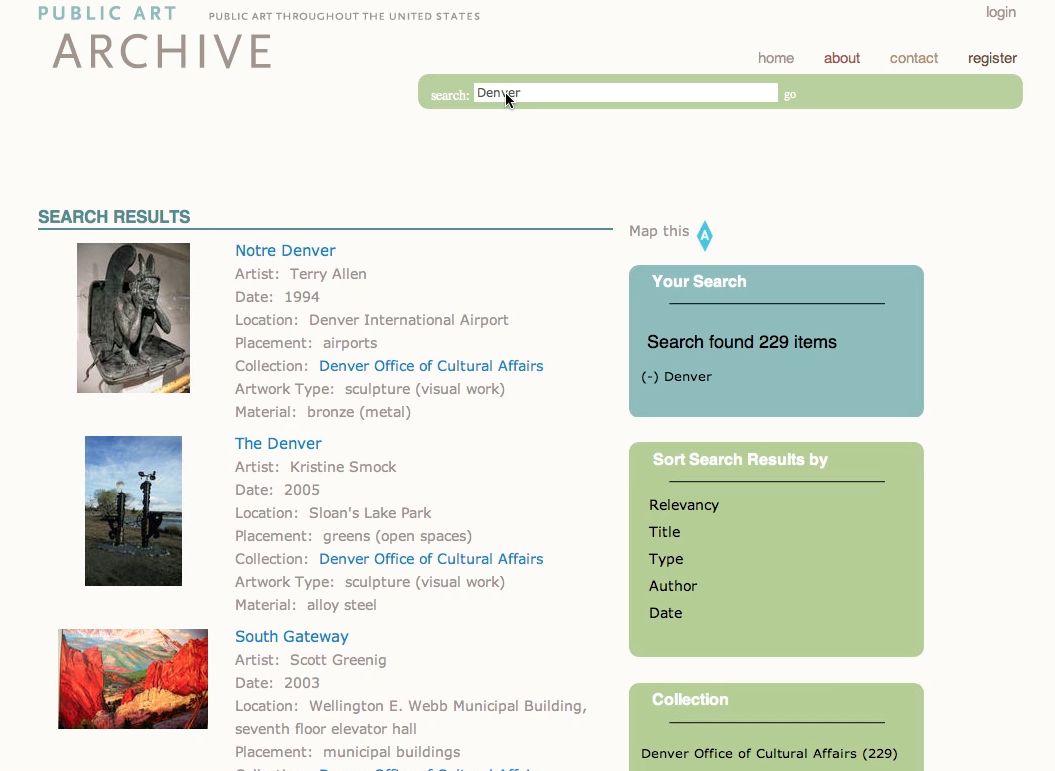
Once they’ve found the artwork they are searching for, users are presented with a variety of information and media about the work. In addition to the artwork’s basic info, users can view pictures and video, download PDFs about the artwork, and listen to audio describing the piece.
While the capability for all this content is built in, individual administrators must submit all information and media for each artwork. The Archive has no limit on the amount of content that can be submitted for each work and submission of the content is free. At a minimum, the site requires a full description for each work, as well as its location, and one high quality image.
To enable use of the Archive when an individual is physically in front of a work of public art, the Archive will be accessible from any web-enabled mobile device. No specific apps will be required, users just plug the main url for the Archive into their phone's web browser to access the full functionality of the site.
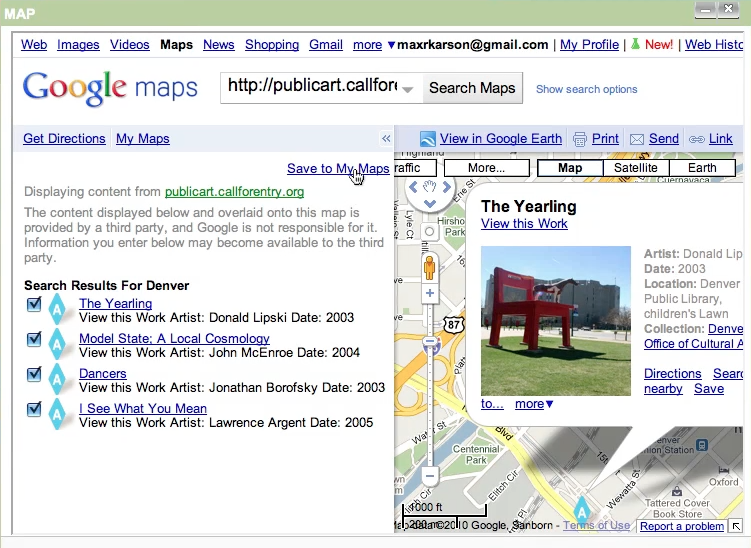
The Public Art Archive will also be fully integrated with Google Maps. By clicking the site’s “Map This” icon, users will be able to view exactly where the artworks are located and build custom maps of artworks that can be shared with others or saved for later use. Administrators can use the mapping function to create custom maps for use in tours of their collection, maintenance tasks, and advocacy initiatives.
The ability for organizations to create personalized pages so they can maintain their identity will be added as the Archive progresses. WESTAF also plans to have licenses available to give organizations access to the more administrative functions of the Archive.
The Public Art Archive will be launching in the near future, but until then visit westaf.org to check out some of WESTAF's other projects that offer technological solutions for arts administrators.
Streaming, streaming everywhere
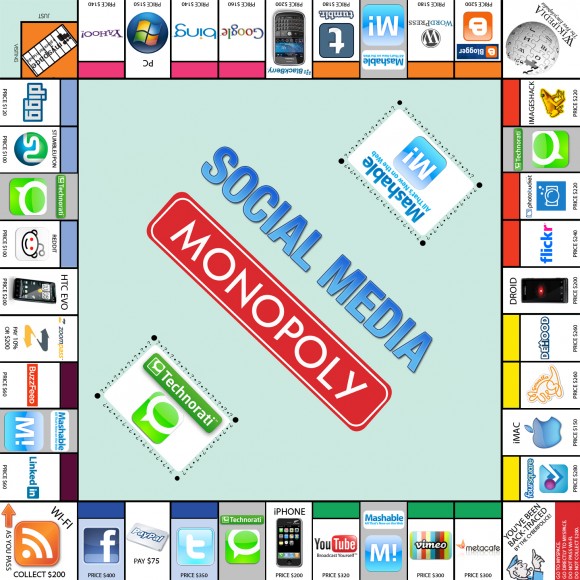 Last week YouTube did a two-day test to preview streaming capability, a move that would place them directly in competition with streaming sites such as livestream, ustream, and justin.tv. Streaming capability was available to four select YouTube partners — Next New Networks, Howcast, Young Hollywood, and Rocketboom for two days. Like the existing streaming sites, YouTube will allow for real-time comments and, eventually, embedding in widgets and archiving old streams.
Last week YouTube did a two-day test to preview streaming capability, a move that would place them directly in competition with streaming sites such as livestream, ustream, and justin.tv. Streaming capability was available to four select YouTube partners — Next New Networks, Howcast, Young Hollywood, and Rocketboom for two days. Like the existing streaming sites, YouTube will allow for real-time comments and, eventually, embedding in widgets and archiving old streams.
In all of YouTube’s communications , they only address giving this capability to their “content partners” anytime in the near future. YouTube content partners are people and companies that post regularly to the site and apply to YouTube in order to monetize their content with ads and rentals, obtain better quality for their uploads, and use YouTube’s Insight analytics tools. (Note: YouTube has a special program for non-profit partners. Check it out.)
Evan Rosenberg of Anaheim Ballet, a member of YouTube’s nonprofit program, produces the series “Anaheim Ballet: More Than Dance…” (See below for an excerpt.) He described the company’s hopes for its channel.
“YouTube has made it possible to not only showcase ourselves (Anaheim Ballet), but ballet in general to a global audience to the tune of over 24 million views. We look forward to using this additional tool (live streaming) in our continuing effort to spread the art of ballet across cultural, age, and economic boundaries.”
One of the videos on Anaheim Ballet's YouTube channel.
What are the implications for performing and performance arts organizations as streaming video becomes more and more ubiquitous? As a company or an artist, live performance is our product. Thus, we have faced issues with online video platforms since their rise in popularity:
We wonder if capturing that artistic product and distributing it online dilutes the aesthetic appeal.
We wonder if we should side with our artists and unions who deserve credit, payment, and a future in their industry, or with the insistent board member who says we must post video to capture the elusive younger market segment. We wonder if these interests are indeed in conflict.
We wonder if it cannibalizes box office revenues. And we wonder if we should give our audience members more credit; we know the difference between live performance and video, and so do they…right?
Online video is here to stay. This announcement is one more step in a long staircase of live streaming video becoming the norm. Fifteen years ago everyone had to have a website. Four years ago everyone had to have a Facebook page. Last year, everyone was going to mobile apps. With YouTube’s announcement, it’s easy to see performance footage moving from the movie theatre and the ballpark to laptops, phones, and iPads.
Speaking of new platforms for video, is everyone aware of the changes coming up for Twitter?
Tech + Art + Mobile + Money = A New Hope for Artists and NPOs?
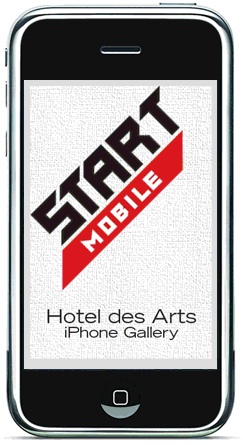 START Mobile offers 18 Mobile Art Galleries
START Mobile offers 18 Mobile Art Galleries
Wouldn't it be great if you could spend a small amount of money to get something cool, and at the same time both support an artist AND the non-profit that supports them?
For example, you could hop on iTunes and look up your favorite museum, your alma mater, your child’s school, your favorite ballet company, and download a gallery of images relating to or by the organization. You could purchase it for less than a buck, and pat yourself on the back for making a donation (when really you were just buying something for yourself).
Thanks to START Mobile, that possibility is rapidly becoming a reality.
Started in 2005, START Mobile’s mission, as described by founder and CEO John Doffing, is to bring “NEW ART to the mobile medium. From the beginning, our vision was one of 'Art for Everyone & Art for Everywhere.’” At the moment, START Mobile is "a bootstrapped startup" that has launched 18 mobile galleries for the iPhone, including one which contains Shepard Fairey's now-controversial Obama image, and promises to launch applications for other platforms in the next few months.
“Technology can facilitate a lot of outside the box thinking relative to the marketing, ownership and appreciation of fine art, and this is a significant part of what START Mobile is trying to accomplish," says Doffing. "[I]t introduces a decidedly egalitarian ethos into an art world that has become inaccessible to the vast majority of potential art lovers.”
A longtime advocate of the arts, Doffing also founded San Francisco's START SOMA Gallery and the Painted Rooms at the Hotel des Artes. He is fierce in his conviction that artists retain the rights to the work that START Mobile licenses, and that they be paid for their work. "There is no charge to the artists that we work with to 'mobilize' their content," explains Doffing. "ALL our artists receive the same commission (and this goes for ALL our art projects): 50% of our net. Or about 10 times what is typically paid to artists to license their work. How much can they make? Depends entirely on how many are sold!"
Apple charges 99¢ for an individual to download one of START Mobile’s artist galleries (a gallery contains multiple images) onto an individual’s iPhone. Apple makes 29¢ off the sale, and the remaining 70¢ is equally split between START Mobile and the artist. Thus, the artist is paid every time anyone, anywhere, downloads the gallery.
Doffing again stepped "outside the box" when he approached Kathy Hanlon Sampon, art teacher at his alma mater, Wisconsin’s Catholic Memorial High School, whose art department was struggling for funds. “During our talks, we discussed [the CMHS art] department’s progress in digital media,” explains Hanlon Sampon. “Since [Doffing] was already developing the program for the app, it would be easy (relatively speaking) to drop our students' work into one of his programs and make it available to the general public – worldwide.”
Hanlon Sampon chose the work that would be included in the CMHS Gallery, digitized the pieces, sent them to Doffing, and START Mobile did the rest--including donating all revenue to the CMHS art department (CMHS is a Catholic non-profit organization). But Hanlon Sampon appreciates more than financial benefits, and says her students now "understand much more about marketing of artwork, the prospect of global visibility, PR, and how technology can be used to not only create art but also to share it.”
START Mobile subsequently released the Pride Gallery by artist Samala (START Mobile Creative Director Christina Samala), who donated her work to raise money to NPO The Courage Campaign. As with CMHS, START Mobile gives 100% of revenue to the Courage Campaign. Though in neither case do the artists directly profit from their work being used, the implications of START Mobile undertaking a project like this are huge.
At this time START Mobile would not be able to sustain itself if every gallery operated like the CMHS and Pride mobile galleries. But perhaps there are artists that would collaborate with non-profits for an equal share of the traditional revenue of 35¢ (after START Mobile takes its cut). START Mobile could become the go-to company for arts organizations wishing to make some money for themselves, the artists, and increase exposure. Galleries could have mobile shows, private schools around the world could have a program like CMHS’s (perhaps public schools could get in on the action if the profits went toward the Booster Club, or were differently packaged). Doffing's long-term goal is "to get our business stable enough that we can do a few dozen apps each month for non-profits that our team supports."
Doffing is optimistic about the potential for artists and organizations to really profit from the galleries, though START Mobile doesn't release sales figures. "If we can manage to crack the top 100 apps in our category on iTunes, sales numbers increase by an order of magnitude. . .There are currently quite a few iPhone wallpaper applications available via iTunes that are selling several thousand units globally per day at 99¢ each - generating several thousand dollars a day in revenue."
"When the CMHS iphone app started getting some press, we received inquiries from around the world wanting to do something similar, representing everything from art museums to non-profits to high school and college art departments. We don't have the resources to do them all, and I have been talking to some folks about automating the process so we can just launch as many of these things as possible [in the future]."
His enthusiasm is contagious, and his positive outlook gives me hope for all of us who have been lamenting the sacrifices that both artists and non-profits make daily. When I told him that I believe many people, like myself "would love the opportunity to support favorite organizations AND get nice wallpaper AND support artists," his reply made me smile:
"Mobile + small-dollar transactions + application model for content delivery enables this for the first time EVER. Pretty exciting."
Yes, it is.
What You Do IS Worth Paying For, We Just Can't: Non-Profit Organizations and Artists - Part 2
Last week I wrote about the indignation I feel when I see a company like Google wanting to use art without financially compensating the artists. The post and ensuing discussion on Facebook generated some interesting feedback, and many people expressed the concern that perhaps artists have set the bar low themselves.
This got me thinking about how it is that artists begin accepting less than they are worth--and I think, unfortunately, it is because of the close collaboration that artists have with non-profit arts organizations. And this is much more difficult to get irate about. As I rail against Google for devaluing the work that artists do, I can't help but think back on the numerous non-profit arts organizations with which I have either been involved or encountered as an artist.
Non-profit organizations, those bastions of hope, those doers of good, whose belief in the arts propels us through the darkest hours of our economic crises, are they immune to the tirade I so readily unleashed on Google?
Here are a couple of scenarios that I have encountered in the last few years.
A small non-profit theater company hires non-Union designers, actors, and tech staff. Due to budget limitations, the theater pays each a scant stipend, which is realistically hardly more than the cost of gas to get to and from rehearsals and shows. The highest pay goes to designers and directors, the lowest to crew and cast.
A small non-profit gallery holds an open call for artists to be featured in a full-color, glossy catalogue that is then distributed (the gallery paying for postage) to 1000+ other institutions around the country, offering exposure for the artists at no cost to them. The artists whose works are featured do not receive a free copy of the book (they pay a mere $5 less for the publication than the general public). The argument is that their price is exactly the cost of publishing one book.
These two organizations have been around for a decade and just under a decade, respectively. Each is respected in its community and the directors of each organization have cut their own personal income as needed (going a year or more at a time without pay from the organization). Their personal sacrifices demonstrate their belief in the necessity of the arts. Their commitment to producing art trumps their desire to live a cushy life. But they ultimately cannot pay the artists a living wage.
Do NPOs perpetuate the undervaluing of art by expecting to have artists' collaboration without paying them What They Are Worth? Doubtless, if either of the above examples had the funds it would pay its artists more--but both organizations benefit, and arguably only exist because of, artists' willingness to work for little-to-nothing. Though there are actors, designers, painters, who choose not to work with the organization because of the financial sacrifice, there are enough others that the organizations continue to exist.
Obviously there is the striking difference between the net worth of Google and that of a small gallery, but the artists are still working for, ultimately, exposure. Perhaps they are not the heavy-hitting "professionals" like the illustrators that Google solicited, but nevertheless, a standard is being set.
Let us be realistic. Just as we, the underpaid in the arts world, raise our fists against the indignity of artists being asked for work without receiving pay, we are often the first to ask for favors from artists. Because we have no money, we do what we can (trade you free admission to our show, etc.), but maybe this is the crux of the issue.
Yes, artists have options. They can join unions (which may limit their opportunities to work) or decline jobs that don't pay what they feel they deserve. They can choose to do it "for the love of it" and hope that the future will be brighter, more lucrative, just around the bend. But should they have to choose?
I don't know what the answer is. I don't feel good about bringing my indignant wrath against non-profit organizations, the likes of which I have worked for, with, and on behalf of, my entire adult life. I feel that it is fair to say, with some notable exceptions, that those individuals who establish non-profits arts organizations, especially sacrificing their own creature comforts to do so, want the best for the artists and want to produce the best art.
But I have seen too many artists who work with such organizations get caught in the seemingly endless cycle of uncertain paychecks, needing to balance additional temporary jobs in an effort to make ends meet, essentially working two or more full-time jobs to enable them to do their art and fill their refrigerators (not to mention pay rent, etc.). That lifestyle can have a negative influence on the art and the artist, and can make an artist's sparkling potential sputter into mediocrity.
Without art there is silence. Without artists we have no stories, no history. When we talk about social media, about technological advancements, what we are really talking about are ways to communicate. We invest in the people who develop the newest, fastest way to transfer information among individuals. But we cannot forget that this is not the only way communication manifests. What about the people communicating in the same way that early man did in his cave paintings, in dances and performances, weavings and body decorations, storytelling and pottery? Art tells us about our history and our nature.
We are human not just because we can cure what ails us, not just because we can problem-solve or analyze or understand quantitative data. We are human because of those feats (artistic in their own right), certainly, but also, especially, because we can communicate through creations that may not be strictly, quantifiably "practical." Art can be healing, therapeutic, exciting, energizing. Art can make sense of the world or touch an individual. Artists create works that convey pain, sorrow, joy, fear, love, hate, anger, celebration. Artists can reach audiences they have never met with the power of their work.
Art makes us human. Non-profits arts organizations need to be able to employ artists at a rate that is livable. I understand that it is much more easily said than done. But we must demand this of ourselves, this should be the goal. We can be the example. Let those who can pay do so. Please. Art is not a luxury item.







